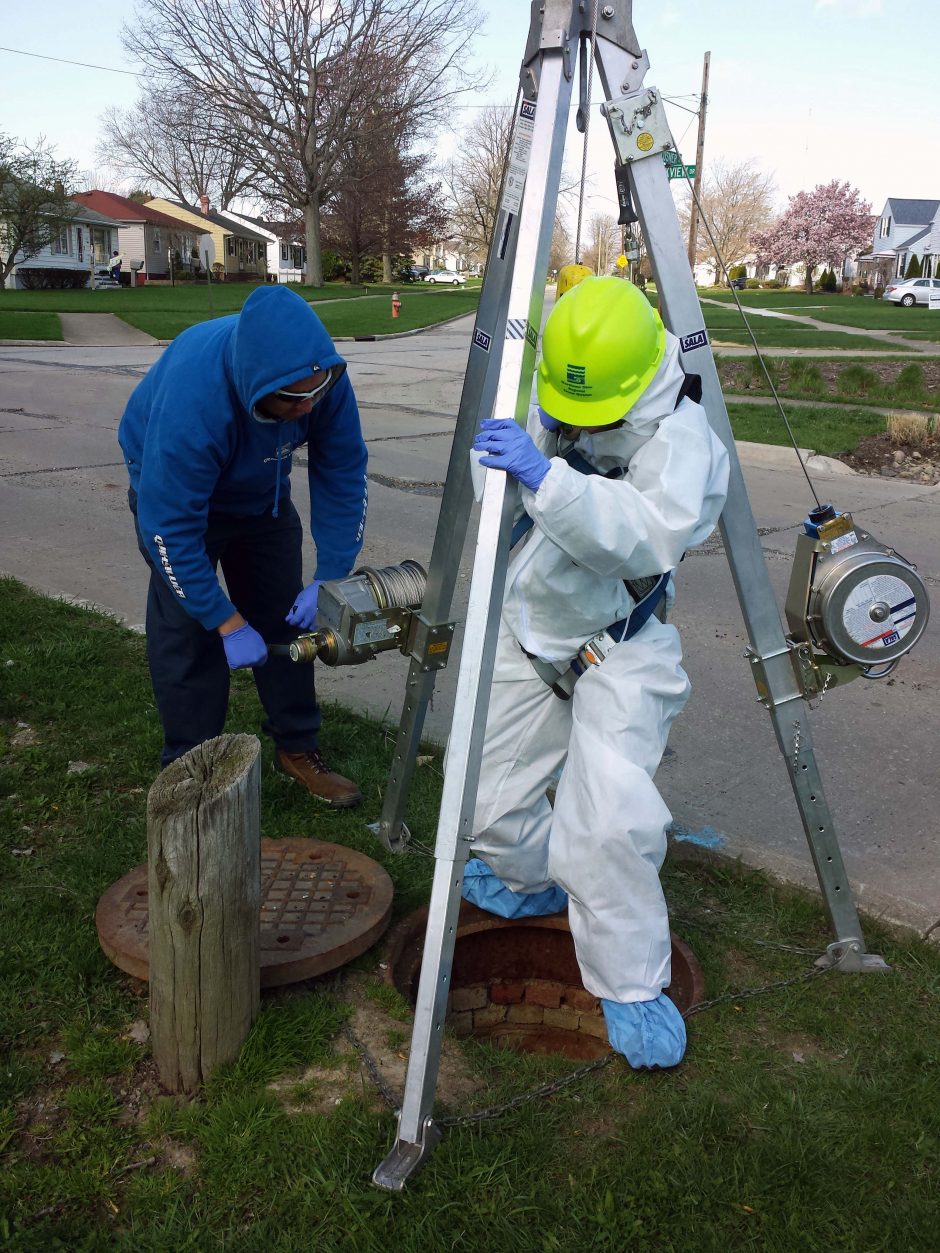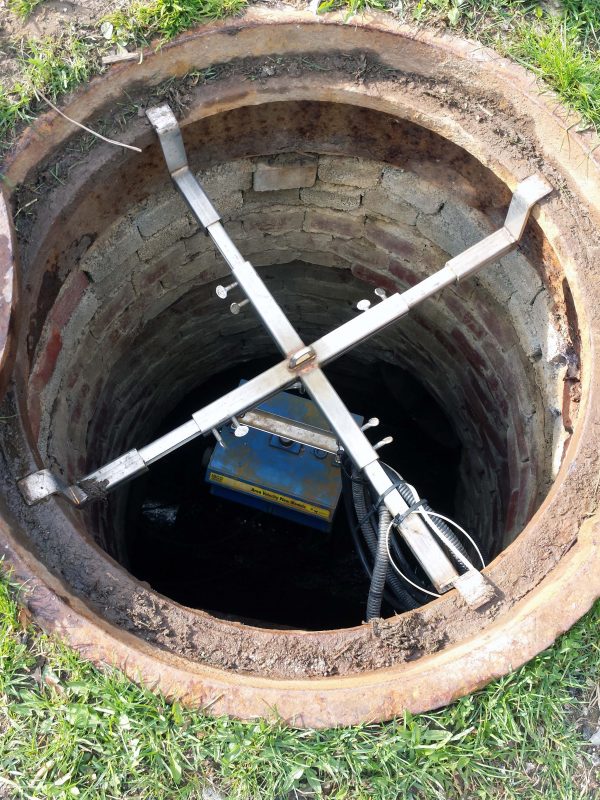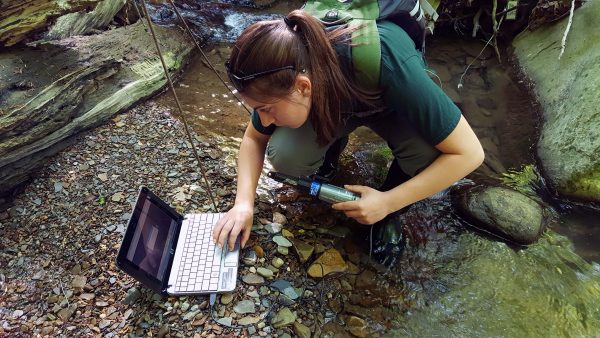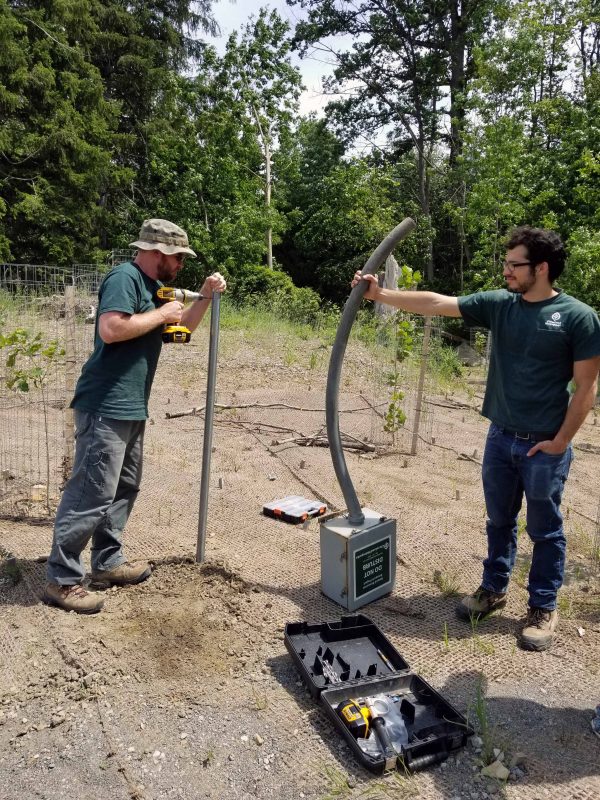From Natural Areas Management to the Watershed Stewardship Center: Cleveland Metroparks Is Where Conservation Meets Innovation

Northeast Ohio Regional Sewer District, Installing flow meters in stormwater manhole in Parma. (Credit: Claire Weldon)
Winner of a 5th National Gold Medal Award for Excellence in the Field of Park and Recreation Management, Cleveland Metroparks is known for its 23,000 acres that include eighteen reservations, hundreds of miles of trails, eight golf courses, two lakefront parks and a zoo. While much effort has been put into conserving pristine natural areas, a lot of work has also gone into improving the nexus of animal and human habitats. Cleveland Metroparks (CMP) manages thousands of acres of wetlands, streams and forests in an effort to protect urban watersheds and maintain the buffer between human and wildlife dwellings. Pollution, algal blooms, invasive species and stormwater are all areas of concern for the Metroparks, which border Lake Erie, an area rich in both wildlife, industry and urban development. Some of their innovative work has been featured in previous Environmental Monitor articles:
- Rare, genetically unique Ohio brook trout could benefit from restored stream
- Cleveland rain garden program benefits neighborhood and Cuyahoga River tributary
- Pursuing Ecology’s ‘Digital Revolution’
By providing naturally functioning forests, wetlands and riparian buffers via the park system, studies estimate an annual value of five million dollars to the greater Cleveland area. Not only has CMP made watershed protection a priority, they have created a nationally recognized Watershed Stewardship Center. The Center is devoted to making watershed stewardship a central focus via education, scientific monitoring and environmental restoration.
“I was drawn to Cleveland Metroparks because they were building a center specially dedicated to improving our local waterways: the Watershed Stewardship Center,” says Jenn Grieser, Senior Natural Resource Manager, Urban Watersheds, for Cleveland Metroparks. Grieser has an MPA degree in Natural Resource Management and Environmental Policy from Indiana University and has worked for CMP for almost eight years. “It’s also been exciting to work in diverse types of watersheds at CMP, from cool, groundwater-fed creeks to warm-water rivers, flat meandering courses to steep and straight streams, urban to rural.” The Watershed Stewardship Center opened in 2013. It includes interpretive displays as well as actual stormwater control measures around the building, transforming current stormwater management theories into practical application.

Flowmeter on its hanger. The probe is 10-15 feet down, installed in sewer district in Parma. (Credit: Claire Weldon)
“We have about 50,000 visitors annually,” says Grieser. “The mission of our facility is to improve our urban watersheds by advancing the science of stormwater management, applying what we’ve learned and involving the community in this endeavor. We want to tell a richer story about stormwater management using our Center. We’ve managed to get additional funding to do this. Each year, we have layered on more questions and delved deeper than before. Our newest phase of research with Kent State University is largely through a special gift from the Ingalls Family Foundation.”
The Kent State University (KSU) work has been a collaborative effort of Grieser, Claire Weldon, Aquatic Research Coordinator at CMP, KSU Department of Geology’s Anne Jefferson and Lauren Kinsman-Costello, with the KSU Department of Biological Sciences.
The latest work compared the efficacy of a green roof vs. bioretention cells at dealing with stormwater runoff. The green roof consists of a vegetation layer, soil layer, filter layer, drainage material and roof layer. The bioretention cells consist of an inlet from the road or parking lot, native plants, a temporary ponding area, an overflow inlet above ground, a mulch layer below, bioretention soil below that and a gravel bed below that. The study included water quantity and quality monitoring for the green roof and bioretention systems.
“Our initial study showed that the green roof exported phosphorus,” says Grieser. “The Park Manager was following guidance on green roof maintenance from the manufacturer. But it turned out that we did not need to add fertilizer to the green roof to encourage growth, as there was already sufficient phosphorus in the soil.” In nature, phosphorus is relatively sparse and is the chemical limiting growth in the environment. Growth does not occur unless sufficient levels of phosphorus are present. In urban environments, fertilizer is ubiquitous, and phosphorus is relatively plentiful. In those cases, phosphorus runoff can cause unintended, even deadly growth, such as Harmful Algal Blooms (HAB) in areas with runoff. “The roof captures rain at 100 percent in a typical shower, but if there’s a large storm event the roof can’t capture all the water,” says Grieser.
The CMP and KSU researchers found that the green roof did not perform as well as the bioretention cells at capturing stormwater. “This is important, as the climate change data we have seen suggests that we will be seeing more intense weather events like severe storms and floods in the future,” says Grieser.

Sierra Wick, Seasonal Aquatic Research Technician, with HOBO temperature logger in coldwater stream. (Credit: Claire Weldon)
One of the strategies for reducing runoff is placing what Grieser calls a “working wetland,” such as the one planted next to the Watershed Stewardship Center, at the bottom of the “treatment train” – a series of stormwater control measures linked together to enhance overall performance. Wetlands excel at removing excess nutrients and pollutants from water, so long as there is not so much that the wetland becomes overwhelmed. The Center’s stormwater was in need of filtering. In addition to phosphorus runoff from the green roof, there was also runoff from a nearby landfill that needed treatment. “The wetlands capture stormwater. What happened was the landfill flow was bypassing a stream. Instead, it entered the working wetlands that KSU was monitoring.” Turbidity data taken before and after overflow from the landfill showed the influence of the landfill runoff on the wetlands. While the working wetland by the Center aids in improving water quality, it also acts as a habitat for wildlife such as turtles, frogs and birds.
“Urban areas have unnatural water flow,” Weldon explains. “Impervious surfaces allow water to flow directly into streams during storms. In a natural habitat, water flow is more gradual and comes into contact with more land and more vegetation before going to a stream. The residence time of the water on the land in nature is significantly longer, making the water receive better filtration from the soil and vegetation, improving the water quality.” Efforts are also being made to restore Cleveland’s canopy, which would also have the effect of obstructing rainfall and increasing rainwater residence time naturally.
“Bioretention cells have proven to be a good way of slowing water down and improving water quality,” says Grieser. “Pervious pavers can also help. Cisterns, which are basically glorified rain barrels, are another method we have of effectively dealing with runoff.”
Weldon, holder of a BS degree in Biology from Baldwin Wallace and a seasoned 11-year veteran of CMP, maintains data gathering equipment and oversees data transfer to research partners. “For the Watershed Stewardship Center, we use ISCO 2150 area velocity flow meters, HOBO U20s water level monitors, soil moisture sensors and a nearby weather station. The equipment used to monitor soil moisture on the Watershed Stewardship Center green roof is a HOBO micro station (H21-002) and a HOBO soil moisture sensor EC5 (S-SMC-M005). In the near future, we will be adding PME turbidity sensors and HOBO conductivity sensors,” she says.

Seasonal Aquatic Research Technicians Owen Lockhart and Alejandro Nevarez install a flowmeter housing by the Acacia restoration site. (Credit: Claire Weldon)
Gathering data and dealing with environmental monitoring equipment often comes with challenges. “Equipment is all different, and often finicky in its own way,” Weldon mentions. “Sometimes it’s not the equipment itself that’s being difficult, it’s the environment the equipment needs to be placed in. Sometimes you have to deal with small diameter pipes, and it’s difficult to get probes where they need to be. Batteries have to be changed out, sometimes two or three times a year. Extreme heat or cold can shorten battery life significantly. Cables can get worn out and need replacing. Some equipment is good for three to ten years, however. Some of our HOBO equipment has batteries that operate for years. Our flowmeters are submerged in outflow pipes. They measure what’s coming off the landfill or working wetland of the bioretention cell. We use the HOBO equipment for groundwater measurements.”
In addition to a strong research program for KSU graduate students, CMP also has a Watershed Volunteer Program for citizen scientists. “For this particular project, we train them to gather water samples and take corresponding measurements,” says Grieser. About a half dozen volunteers participated in the earlier phases of this project, but interest is growing. The Park District has a cadre’ of 100+ certified watershed volunteers to recruit for this research. The new training program for Watershed Volunteers starts mid-July.
While there is still much work yet to be done by researchers and volunteers, both Weldon and Grieser have enjoyed their years with CMP. “Cleveland Metroparks is diverse,” says Weldon. “I grew up with CMP. It has always had so much to offer. There’s always something new here. I’ve also enjoyed getting to intimately know our streams. I like learning how to use new equipment and troubleshooting new problems. It’s never boring.” Grieser adds, “I enjoy interacting with dedicated staff and volunteers that love our natural resources. I also enjoy the research challenges. There’s been a lot of discussion in the technical world about having a research plan up front that basically follows the data from collection to analysis and publication. In some cases, we have instrumented streams or storm sewers without knowing exactly who will do the analysis and reporting. And for the most part, we have found interested academics or consultants. So I’ve been glad that we could anticipate potential research and/or management interest, and be able to provide quality data.”
Top image: Northeast Ohio Regional Sewer District, Installing flow meters in stormwater manhole in Parma. (Credit: Claire Weldon)




0 comments